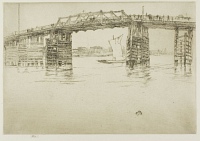Etchings Institutions search term: glasgow herald
Old Battersea Bridge | ||
| Number: | 188 | |
| Date: | 1879 | |
| Medium: | etching and drypoint | |
| Size: | 202 x 293 mm | |
| Signed: | butterfly at lower right (2-6); replaced with new butterfly (6); replaced again (7) | |
| Inscribed: | no | |
| Set/Publication: | Fine Art Society, 1879 | |
| No. of States: | 7 | |
| Known impressions: | 40 | |
| Catalogues: | K.177; M.174; W.141 | |
| Impressions taken from this plate (40) | ||
KEYWORD
TITLE
'Old Battersea Bridge' (1879, Whistler). 3
'Old Battersea' (1881, Union League Club). 4
'Battersea Bridge' (1886, Frederick Wedmore (1844-1921)). 5
'Battersea Bridge' (1887/1888, Whistler). 6
'Old Battersea Bridge No. 1' (1890/1892, Beatrice Whistler (1857-1896)). 7
'Old Battersea Bridge' (1909, Howard Mansfield (1849-1938)). 8
The bridge was not only old, it was being replaced, so the title 'Old Battersea Bridge' is appropriate. Although Beatrice Whistler's numbering is understandable - since there were several etchings of the bridge - it is not needed here.
3: 3 August 1879, GUW #13008.
4: New York 1881 (cat. no. 155).
5: Wedmore 1886 A (cat. no. 141).
6: List, [August 1887/1888], GUW #13233.
7: List, [1890/1892], GUW #12715.
8: Mansfield 1909 (cat. no. 174).
DESCRIPTION
SITE
9: 'Freeing the Bridges', The Times, London, 24 May 1879, p. 12.
10: Lochnan 1984 , pp. 179-180.
DISCUSSION

Old Battersea Bridge [c018], lithograph, 1879, 1887.
The Hunterian, University of Glasgow (49024).
Seeing this lithograph, Old Battersea Bridge [c018], exhibited in 1895, F.G. Stephens remarked that it 'reminds one of the sketcher's admirable etching of the subject.' 11
11: The Athenaeum, 21 December 1895, p. 878.

The Tall Bridge [c012], lithograph, 1878,
The Hunterian, University of Glasgow (49019).
Old Battersea Bridge [m0700] and The Tall Bridge [m0701], dating from 1878, are closer in scale and detail to the etching, but are in fact chalk studies for two lithographs, The Broad Bridge [c011] and The Tall Bridge [c012] (reproduced above). The pier that appears on the right of The Tall Bridge may be the same one that is seen second from left in the etching Old Battersea Bridge. The whole bridge is seen again, rather fuzzily, in the lithograph Old Battersea Bridge, No. 2 [c013], and finally in Old Battersea Bridge [c018], which was drawn from a boat at high tide, when the water conceals much of the piers.
12: Lochnan 1984 , pp. 179-180.

Okada Shuntosai, Cinsen (Doban Hosoye Shu), woodcut.
Whistler Collection, The Hunterian, GLAHA 18792.
Cinsen (Doban Hosoye Shu) a series of views of famous sites of Edo by , in a small book that was in Whistler's collection, includes two views of a bridge. One scene, an aerial view of a bridge, reproduced above, shows passers-by and carts on the bridge, ships below, and Mount Fuji in the distance. 13 14

Another woodcut from the same volume (reproduced above), shows the curve of the bridge across the centre of the plate, the roadway crowded with pedestrian traffic, fireworks above and boats in the river below, flanked by stylised landscape features, including roofs across the foreground. 15
13: Book, 31 sheets, 130 x 258 mm, prints 68 x 121 mm, The Hunterian, GLAHA 18792.
14: See Westminster Bridge in Progress [77] for a further discussion of Asian influences on Whistler's bridge compositions.
15: See Westminster Bridge in Progress [77] for a further discussion of Asian influences on Whistler's bridge compositions.




